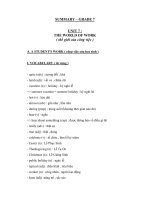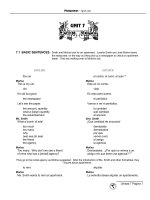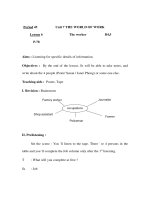Unit 7 public transport study
Bạn đang xem bản rút gọn của tài liệu. Xem và tải ngay bản đầy đủ của tài liệu tại đây (72.04 KB, 6 trang )
Authors: Do Viet Hai – Phan Hoang Nam
1 English for Road and Bridge Engineering
Unit 7: PUBLIC TRANSPORT
INTRODUCTION
Public transport (also public
transportation or public transit) is a
shared passenger transportation service
which is available for use by the
general public, as distinct from modes
such as taxicab, car pooling or hired
buses which are not shared by
strangers without private arrangement.
Public transport modes include buses, trolleybuses, trams and trains, rapid transit
(metro/subways/undergrounds etc) and ferries. Public transport between cities is
dominated by airlines, coaches, and intercity rail. High-speed rail networks are
being developed in many parts of the world.
Most public transport runs to a scheduled timetable with the most frequent services
running to a headway. Share taxi offers on-demand services in many parts of the
world and some services will wait until the vehicle is full before it starts. Paratransit
is sometimes used in areas of low-demand and for people who need a door-to-door
service.
Urban public transport may be provided by one or more private transport operators
or by a transit authority. Public transport services are usually funded by government
subsidies and fares charged to each passenger. Services are normally regulated and
possibly subsidized from local or national tax revenue. Fully subsidized, zero-fare
(free) services operate in some towns and cities.
For historical and economic reasons, there are differences internationally regarding
use and extent of public transport. While countries in Old World tend to have
extensive and frequent systems serving their old and dense cities, many cities of the
New World have more sprawl and much less comprehensive public transport.
Authors: Do Viet Hai – Phan Hoang Nam
2 English for Road and Bridge Engineering
THE ADVANTAGES OF USING PUBLIC TRANSPORT SYSTEMS
A public transport system is a shared public mass transportation form that is
provided for use to the general public. These systems are organized and efficient,
and come in many forms, from the Subway or bus to a taxi to trams, coaches,
airplanes, and high speed railways. Many of us are so reliant upon our own personal
vehicles that we rarely give any thought to the benefits of using these public modes
of transportation. However, if you live in a city or other area where you could easily
utilize these daily, you should know that it can actually make your life easier.
There are many reasons why public transport is a great idea. It can save you a lot of
money. Everyone knows how expensive it is to fill your car up with gas. Not to
mention the cost of the car itself and insurance protection that you need to cover it.
Owning your own vehicle is a pretty major expense. And while you do have to pay
to ride public transportation systems, it will likely end up being a whole lot cheaper,
especially if you do it often.
It can also offer great convenience. Tired of fighting traffic day after day to get to
your job? Consider that the subway or tram may just miss all this traffic. Not to
mention the fact that it allows you more time to be focused on other things. Rather
than driving, you can be making business calls, planning your day, or jotting down
notes. All you have to do is show up and get on board and you will be escorted to
your destination. The service could not be better.
There are some who like to be in control, and feel that they can be more so when
they drive their own vehicle. However, if you call forking out a lot of money each
month and waiting in hour long traffic being in control, then consider the
alternative: peacefully relaxing in the back of a cab or flying through the air on a
plane, blissfully unaware of traffic accidents below that will have traffic backed up
for hours. Public transports can also be quite helpful when you are traveling to other
countries. It is obviously not realistic to consider taking your car overseas, so your
only alternatives are to rent a vehicle when you get there or ride the public system.
When you realize that roadways and signs in other countries are often a little
confusing, you may opt for allowing yourself to be escorted from place to place. It
will make your day more relaxing, too.
Authors: Do Viet Hai – Phan Hoang Nam
3 English for Road and Bridge Engineering
PUBLIC TRANSPORT VERSUS OWNING A CAR
Public transport services are offered in most major cities all around the world. It
offers a cheap alternative to the cost of owning a vehicle or paying for a taxi when
you visit outside of your home town. Even if you have the money to purchase a car
to begin with, you have a number of other expenses to deal with.
The cost of gas and maintenance fees such as oil changes and new tires can add up
to be more than the fees for a monthly pass. While it depends on the time of day
you are travelling, it can even be a faster way to get into town. Otherwise, it's up to
you do determine if you can have the extra time to spend on travel.
Parking fees should be considered as well. If you aren't paying for hourly parking,
you will be looking at high fees for day passes or monthly parking. Without your
own regular space, you need to spend time and energy finding a place to put your
car and hope that you're within a reasonable walking distance to your work or target
location.
You also do not have to worry about the extra money needed to repair a car when it
breaks down. Whether money is tight or not, it is never fun to have to worry about
getting your car to a shop and handing over hard earned cash that you would
otherwise not have to spend.
Getting to know public transportation in any city, whether it's in your home town or
not, is not always easy. Unfortunately, it is not going to be the same everywhere
you go. However, once you figure out how to use the public transport where you are
it can be well worth the effort you put in.
Authors: Do Viet Hai – Phan Hoang Nam
4 English for Road and Bridge Engineering
Vocabulary
Word Pronounced Meaning
public transport
public transportation
public transit
passenger
taxicab
car pooling
hired bus
trolleybus
tram
train
metro
subway
underground
ferry
scheduled timetable
coach
intercity rail
paratransit
transit authority
personal vehicle
benefit
insurance
protection
peacefully
blissfully
public transport service
maintenance fee
parking fee
extra money
energy
Authors: Do Viet Hai – Phan Hoang Nam
5 English for Road and Bridge Engineering
Further reading
HANOI METRO
Hanoi Urban Metro (Hanoi Metro) is a metro rail system that will be developed in
Hanoi, Vietnam, by 2020. The project is part of an integrated development
programme for urban transport in Hanoi and will provide a safe, efficient and clean
urban transportation system. It is the fourth-biggest project in Vietnam to utilise the
Japanese Government’s official development assistance capital.
Hanoi is the capital of Vietnam and the country's second-largest city, with a
population of about six million. Many trains, including services to Hai Phong and
Ho Chi Minh City, depart from Hanoi station. The Union Express travels from
Hanoi to Ho Chi Minh City, stopping at cities and towns along the route.
Commuters in Hanoi use motorbikes, buses, taxis and bicycles. The metro project is
part of the Vietnam Ministry of Transport's master plan, which aims to reduce the
use of private transport and enhance the urban environment.
The metro system will have five routes. The main route - line 3 - will be the first
metro line in Hanoi. On completion, the route will provide transport to 200,000
passengers a day. It broke ground in September 2010 and is expected to become
operational by the end of 2015.
The entire project is being carried out by Hanoi Metropolitan Rail Transport Project
Board (HRB), formerly known as the Hanoi Authority for Tram and Public
Transport Development Management (HATD). Technical studies of the system
were completed in 2009.
Project
The feasibility study for a Hanoi metro pilot route / line was completed in October
2005 and design of the pilot line started in 2007. The pilot route will be an east-
westbound line and will connect 12 stations in the city bewteen Hanoi station and
Nhon depot.
The 12.5km pilot line will incorporate a 5.5km single track U-viaduct and a 4km
twin tunnel structure. The system will include 9.6km of elevated and 2.9km of
Authors: Do Viet Hai – Phan Hoang Nam
6 English for Road and Bridge Engineering
underground sections, and will use 20m metro trains top transport 900 passengers in
a single trip. The trains will run at 80km/h, covering the entire route in 20 minutes.
International consulting engineers HRB and SYSTRA signed two contracts to
construct the pilot line. Each contract is worth €36m and the total cost of the pilot
line is about €500m.
SYSTRA will assist with the commissioning, launch and operation of the service
and will supervise the construction and manufacture of rolling stock. It also
provided design studies and assessed bids. The metro's infrastructure will include a
viaduct, an underground section, stations, a depot and rolling stock maintenance
centre and power supply stations. The construction of line two will begin in 2011
and is expected to be operational in January 2016.
Line routes
Hanoi Metro's routes will include Nam Thang Long to Tran Hung Dao, Nhon to
Hanoi station, Cat Linh to Ha Dong and Yen Vien to Ngoc Hoi. The route
connecting Nam Thang Long and Tran Hung Dao will be 11.54km long and serve
ten stations. The line will include an 8.55km underground section. The pilot line
(line 3) between Nhon depot and Hanoi station will start at Nhon and travel to Cau
Giay via National Highway 32, Ho Tung Mau and Xuan Thuy. It will also pass
through Kim Ma, Nui Truc and Quoc Tu Giam. The 13km-route connecting Cat
Linh and Ha Dong will travel from Cat Linh to Thai Thinh via Hao Nam and Hoang
Cau. From Thai Thinh the line will move towards National Highway 6, connecting
Nga Tu So, Nguyen Trai, Tran Phu and Quang Trung.
Financing
The project is being coordinated and financed by several organisations including the
World Bank, the Asian Development Bank and the European Investment Bank. The
latter has granted a €173m loan to help fund the construction of line 3. Part of the
project is being financed by Agence Française de Développement (AFD). The
money provided by AFD is being used to construct the pilot line's infrastructure.
The project is being co-financed by bilateral overseas development assistance loans.
They amount to €280m, of which €200m is tied and €80m is untied.
Source: railway-technology.com









